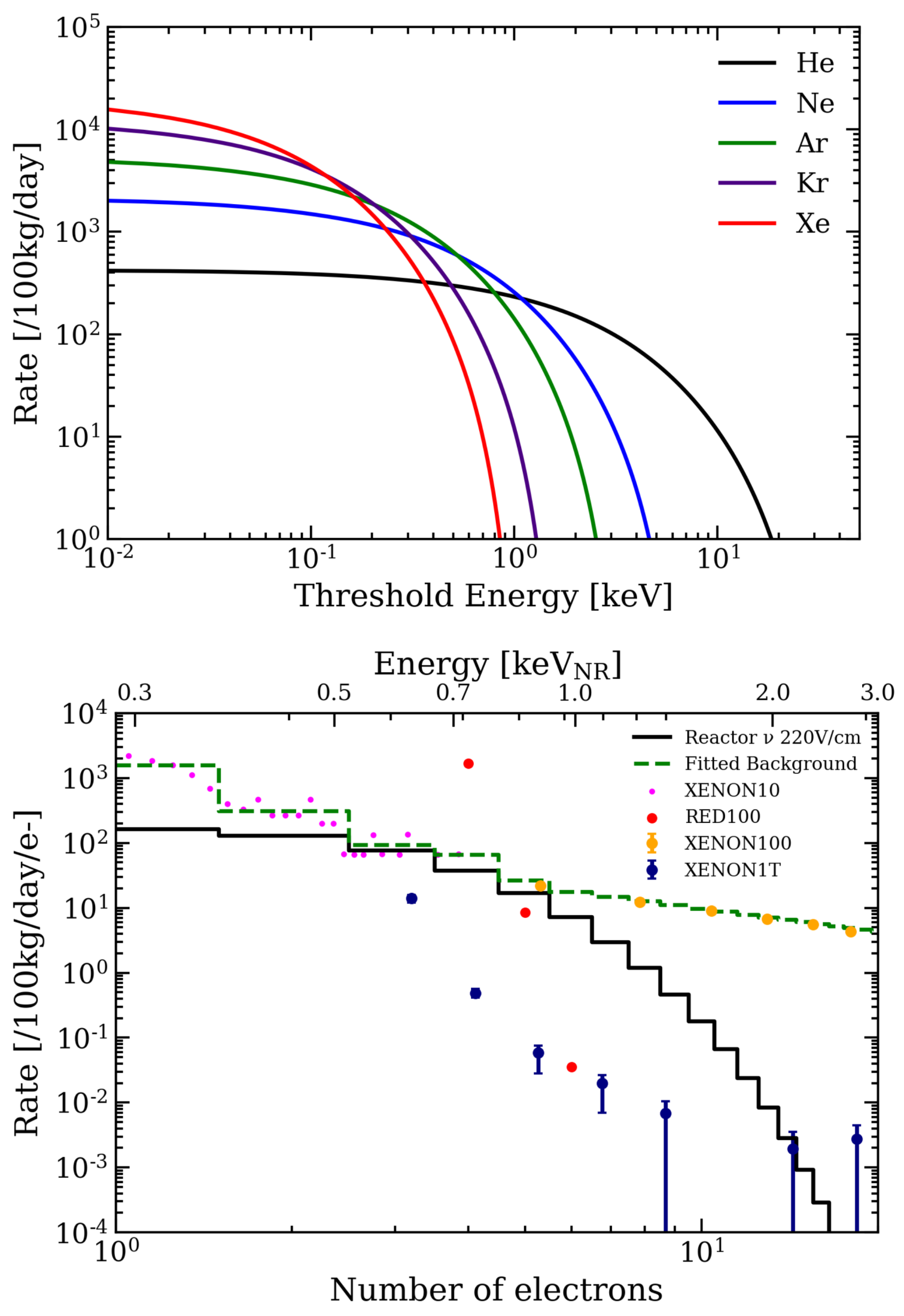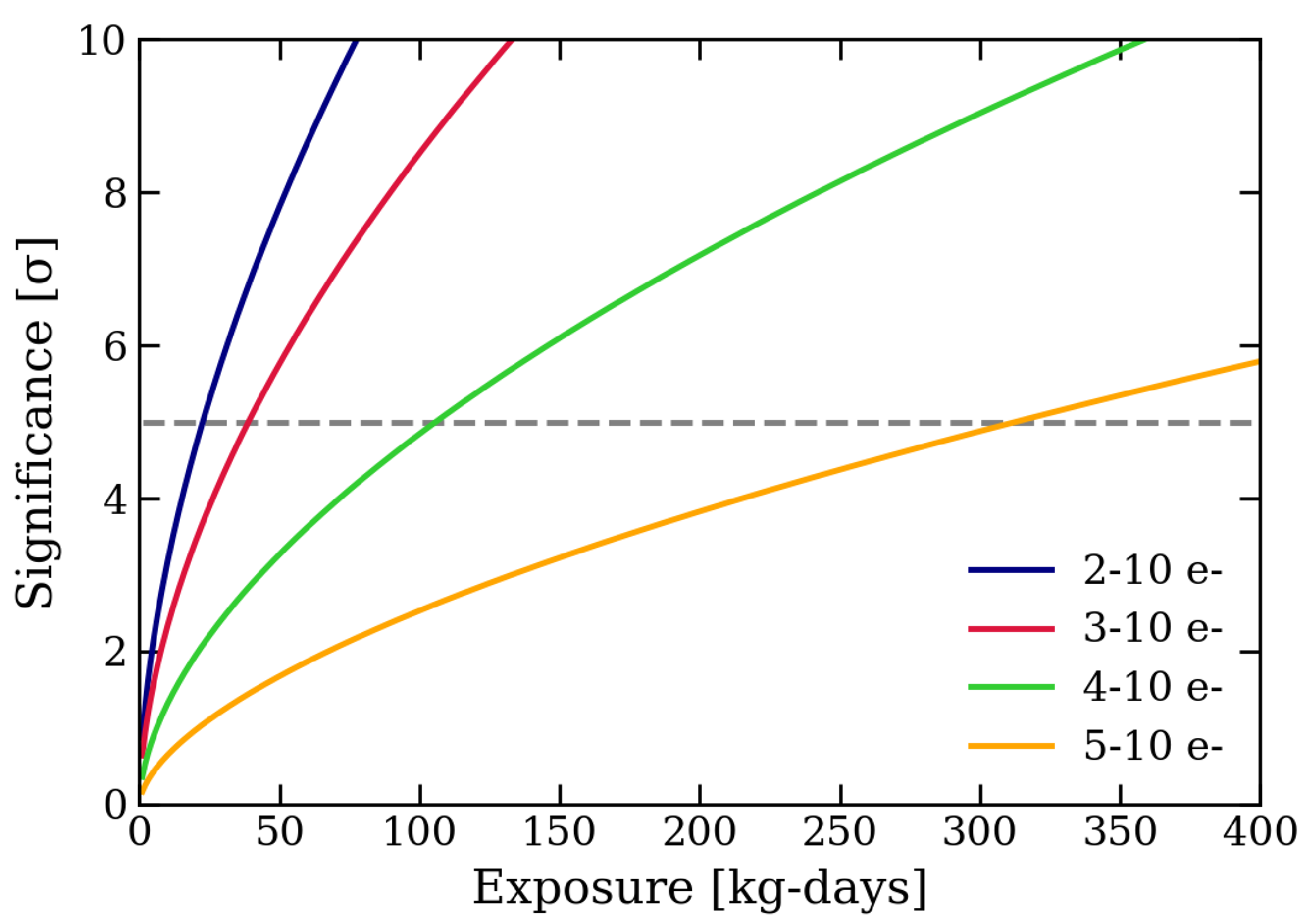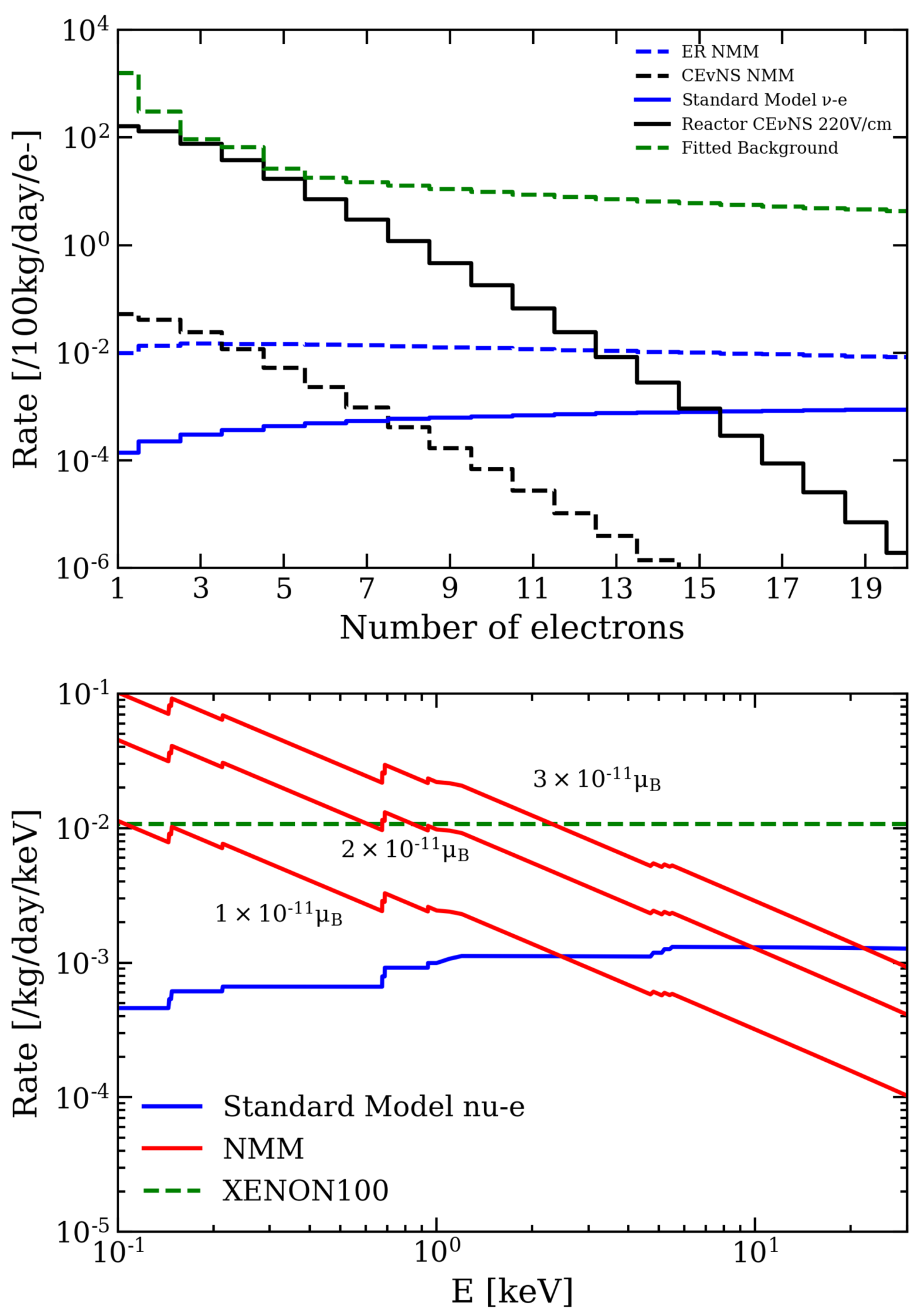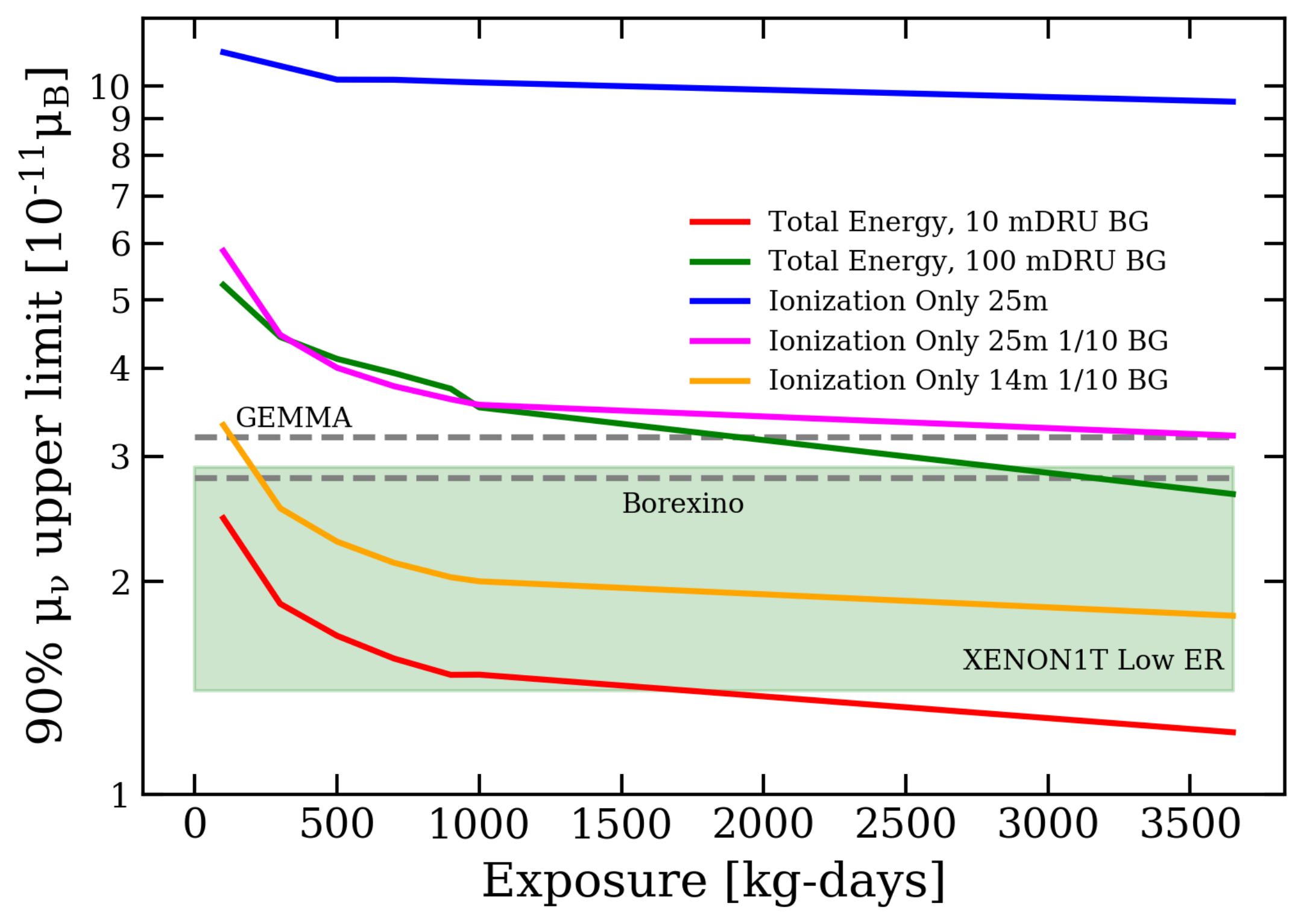Sensitivity of a Liquid Xenon Detector to Neutrino–Nucleus Coherent Scattering and Neutrino Magnetic Moment from Reactor Neutrinos
Abstract
1. Introduction
2. Liquid Xenon for the Detection of CENS Events from Reactor Neutrinos
3. Discovery Significance to Detect Reactor Neutrinos
4. Sensitivity to Neutrino Magnetic Moment
5. Summary
Author Contributions
Funding
Acknowledgments
Conflicts of Interest
References
- Billard, J.; Carr, R.; Dawson, J.; Figueroa-Feliciano, E.; Formaggio, J.A.; Gascon, J.; Heine, S.T.; De Jesus, M.; Johnston, J.; Lasserre, T.; et al. Coherent Neutrino Scattering with Low Temperature Bolometers at Chooz Reactor Complex. J. Phys. G 2017, 44, 105101. [Google Scholar] [CrossRef]
- Agnolet, G.; Baker, W.; Barker, D.; Beck, R.; Carroll, T.J.; Cesar, J.; Cushman, P.; Dent, J.B.; Rijck, S.D.; Dutta, B.; et al. Background Studies for the MINER Coherent Neutrino Scattering Reactor Experiment. Nucl. Instrum. Meth. A 2017, 853, 53–60. [Google Scholar] [CrossRef]
- Akimov, D.Y.; Berdnikova, A.B.; Belov, V.A.; Bolozdynya, A.I.; Burenkov, A.A.; Efremenko, Y.V.; Gusakov, Y.V.; Etenko, A.V.; Kaplin, V.A.; Khromov, A.V.; et al. RED-100 detector for the first observation of the elastic coherent neutrino scattering off xenon nuclei. J. Phys. Conf. Ser. 2016, 675, 012016. [Google Scholar] [CrossRef]
- Wei, Y.T.; Guan, M.Y.; Liu, J.C.; Yu, Z.Y.; Yang, C.G.; Guo, C.; Xiong, W.X.; Gan, Y.Y.; Zhao, Q.; Li, J.J. Prospects of detecting the reactor -Ar coherent elastic scattering with a low threshold dual-phase argon time projection chamber at Taishan. arXiv 2020, arXiv:2012.00966. [Google Scholar]
- Aguilar-Arevalo, A.; Bertou, X.; Bonifazi, C.; Cancelo, G.; Castañeda, A.; Vergara1, B.C.; Chavez, C.; D’Olivo1, J.C.; Anjos, J.C.; Estrada, J.; et al. Exploring low-energy neutrino physics with the Coherent Neutrino Nucleus Interaction Experiment. Phys. Rev. D 2019, 100, 092005. [Google Scholar] [CrossRef]
- Buck, C.; Fülber, K.; Hakenmüller, J.; Heusser, G.; Lindner, M.; Maneschg, W.; Rink, T.; Strecker, H.; Schierhuber, T.; Wagner, V.; et al. A novel experiment for coherent elastic neutrino nucleus scattering: CONUS. J. Phys. Conf. Ser. 2020, 1342, 012094. [Google Scholar] [CrossRef]
- Strauss, R.; Rothe, J.; Petricca, F.; Schönert, S. The ν-cleus experiment: Gram-scale cryogenic calorimeters for a discovery of coherent neutrino scattering. J. Phys. Conf. Ser. 2020, 1342, 012132. [Google Scholar] [CrossRef]
- Freedman, D.Z. Coherent effects of a weak neutral current. Phys. Rev. D 1974, 9, 1389–1392. [Google Scholar] [CrossRef]
- Akimov, D.; Albert, J.B.; An, P.; Awe, C.; Barbeau, P.S.; Becker, B.; Belov, V.; Brown, A.; Bolozdynya, A.; Cabrera-Palmer, B.; et al. Observation of Coherent Elastic Neutrino-Nucleus Scattering. Science 2017, 357, 1123–1126. [Google Scholar] [CrossRef]
- Akimov, D.; Albert, J.B.; An, P.; Awe, C.; Barbeau, P.S.; Becker, B.; Belov, V.; Blackston, M.A.; Blockland, A.; Bolozdynya, A.; et al. First Detection of Coherent Elastic Neutrino-Nucleus Scattering on Argon. arXiv 2020, arXiv:2003.10630. [Google Scholar]
- Angle, J.; Aprile, J.; Arneodo, F.; Baudis, L.; Bernstein, A.; Bolozdynya, A.I.; Coelho, L.C.C.; Dahl, C.E.; DeViveiros, L.; FerellaWagner, A.D.; et al. Search for light dark matter in XENON10 data. Phys. Rev. Lett. 2011, 107, 051301. [Google Scholar] [CrossRef] [PubMed]
- Aprile, E.; Aalbers, J.; Agostini, F.; Alfonsi, M.; Amaro, F.D.; Anthony1, M.; Arneodo, F.; Barrow, P.; Baudis, L.; Bauermeister, B.; et al. Low-mass dark matter search using ionization signals in XENON100. Phys. Rev. 2016, D94, 092001. [Google Scholar] [CrossRef]
- Agnes, P.; Albuquerque, I.F.M.; Alexander, T.; Alton, A.K.; Araujo, G.R.; Asner, D.M.; Ave, M.; Back, H.O.; Baldin, B.; Batignani, G.; et al. Low-Mass Dark Matter Search with the DarkSide-50 Experiment. Phys. Rev. Lett. 2018, 121, 081307. [Google Scholar] [CrossRef] [PubMed]
- Aprile, E.; Aalbers, J.; Agostini, F.; Alfonsi, M.; Althueser, L.; Amaro, F.D.; Antochi, V.C.; Angelino, E.; Arneodo, F.; Barge, D.; et al. Light Dark Matter Search with Ionization Signals in XENON1T. Phys. Rev. Lett. 2019, 123, 251801. [Google Scholar] [CrossRef] [PubMed]
- Hagmann, C.; Bernstein, A. Two-phase emission detector for measuring coherent neutrino-nucleus scattering. IEEE Trans. Nucl. Sci. 2004, 51, 2151–2155. [Google Scholar] [CrossRef]
- Back, H.O.; Calaprice, F.; Condon, C.; de Haas, E.; Ford, R.; Galbiati, C.; Goretti, A.; Hohman, T.; Inanni, A.; Loer, B.; et al. First Large Scale Production of Low Radioactivity Argon From Underground Sources. arXiv 2012, arXiv:1204.6024. [Google Scholar]
- Sangiorgio, S.; Joshi, T.; Bernstein, A.; Coleman, J.; Foxe, M.; Hagmann, C.; Jovanovic, I.; Kazkaz, K.; Mavrokoridis, K.; Mozin, V.; et al. First demonstration of a sub-keV electron recoil energy threshold in a liquid argon ionization chamber. NIM A 2013, 728, 69–72. [Google Scholar] [CrossRef]
- Akimov, D.Y.; Belov, V.A.; Bolozdynya, A.I.; Dolgolenko, A.G.; Efremenko, Y.V.; Etenko, A.V.; Galavanov, A.V.; Gouss, D.V.; Gusakov, Y.V.; Kdib, D.E.; et al. First ground-level laboratory test of the two-phase xenon emission detector RED-100. arXiv 2019, arXiv:1910.06190. [Google Scholar] [CrossRef]
- Akerib, D.S.; Akerlof, C.W.; Alsum, S.K.; Araújo, H.M.; Arthurs, M.; Bai, X.; Bailey, A.J.; Balajthy, J.; Balashov, S.; Bauer, D.; et al. Projected WIMP Sensitivity of the LUX-ZEPLIN (LZ) Dark Matter Experiment. arXiv 2018, arXiv:1802.06039. [Google Scholar]
- Aprile, E.; Aalbers, J.; Agostini, F.; Alfonsi, M.; Althueser, L.; Amaro, F.D.; Antochi, V.C.; Angelino, E.; Angevaare, J.R.; Arneodo, F.; et al. Projected WIMP sensitivity of the XENONnT dark matter experiment. J. Cosmol. Astropart. Phys. 2020, 11, 31. [Google Scholar] [CrossRef]
- Aalbers, J.; Agostini, F.; Alfonsi, M.; Amaror, F.D.; Amsler, C.; Aprile, E.; Arazi, L.; Arneodo, F.; Barrow, P.; Baudis, L.; et al. DARWIN: Towards the ultimate dark matter detector. J. Cosmol. Astropart. Phys. 2016, 11, 17. [Google Scholar] [CrossRef]
- Essig, R.; Sholapurkar, M.; Yu, T.T. Solar neutrinos as a signal and background in direct-detection experiments searching for sub-GeV dark matter with electron recoils. Phys. Rev. D 2018, 97, 095029. [Google Scholar] [CrossRef]
- Lewin, J.; Smith, P. Review of mathematics, numerical factors, and corrections for dark matter experiments based on elastic nuclear recoil. Astropart. Phys. 1996, 6, 87–112. [Google Scholar] [CrossRef]
- Hayes, A.C.; Vogel, P. Reactor Neutrino Spectra. Ann. Rev. Nucl. Part. Sci. 2016, 66, 219–244. [Google Scholar] [CrossRef]
- Ishimoto, S.; Omori, T.; Arima, H.; Ishibashi, K. Simple Calculation of Reactor Antineutrino Energy Spectrum by the Use of Nuclear Data Libraries. J. Nucl. Sci. Technol. 2002, 39, 670–672. [Google Scholar] [CrossRef][Green Version]
- Aprile, E.; Angle, J.; Arneodo, F.; Baudis, L.; Bernstein, A.; Bolozdynya, A.; Brusov, P.; Coelho, L.C.C.; Dahl, C.E.; DeViveiros, L.; et al. Design and Performance of the XENON10 Dark Matter Experiment. Astropart. Phys. 2011, 34, 679–698. [Google Scholar] [CrossRef]
- Aprile, E.; Arisaka, K.; Arneodo, F.; Askin, A.; Baudis, L.; Behrens, A.; Brown, E.; Cardoso, J.M.R.; Choi, B.; Clin, D.; et al. The XENON100 Dark Matter Experiment. Astropart. Phys. 2012, 35, 573–590. [Google Scholar] [CrossRef]
- Lenardo, B.; Xu, J.; Pereverzev, S.; Akindele, O.A.; Naim, D.; Kingston, J.; Bernstein, A.; Kazkaz, K.; Tripathi, M.; Awe, C.; et al. Measurement of the ionization yield from nuclear recoils in liquid xenon between 0.3–6 keV with single-ionization-electron sensitivity. arXiv 2019, arXiv:1908.00518. [Google Scholar]
- Essig, R.; Manalaysay, A.; Mardon, J.; Sorensen, P.; Volansky, T. First Direct Detection Limits on sub-GeV Dark Matter from XENON10. Phys. Rev. Lett. 2012, 109, 021301. [Google Scholar] [CrossRef] [PubMed]
- Aprile, E.; Alfonsi, M.; Arisaka, K.; Arneodo, F.; Balan, C.; Baudis, L.; Bauermeister, B.; Behrens, A.; Beltrame, P.; Bokeloh, K.; et al. Observation and applications of single-electron charge signals in the XENON100 experiment. J. Phys. 2014, G41, 035201. [Google Scholar] [CrossRef]
- Akerib, D.S.; Alsum, S.; Araújo, H.M.; Bai, X.; Balajthy, J.; Baxter, A.; Bernard, E.P.; Bernstein, A.; Biesiadzinski, T.P.; Boulton, E.M.; et al. Investigation of background electron emission in the LUX detector. arXiv 2020, arXiv:2004.07791. [Google Scholar] [CrossRef]
- Sorensen, P.; Kamdin, K. Two distinct components of the delayed single electron noise in liquid xenon emission detectors. J. Instrum. 2018, 13, P02032. [Google Scholar] [CrossRef]
- Sorensen, P. Electron train backgrounds in liquid xenon dark matter search detectors are indeed due to thermalization and trapping. arXiv 2017, arXiv:1702.04805. [Google Scholar]
- Sato, K.; Yamashita, M.; Ichimura, K.; Itow, Y.; Kazama, S.; Moriyama, S.; Ozaki, K.; Suzuki, T.; Yamazaki, R. Development of Dual-phase Xenon TPC with a Quartz Chamber for Direct Dark Matter Search. arXiv 2019, arXiv:1910.13831. [Google Scholar]
- Wei, Y.; Long, J.; Lombardi, F.; Jiang, Z.; Ye, J.; Ni, K. Development of a Sealed Liquid Xenon Time Projection Chamber with a Graphene-Coated Electrode. arXiv 2020, arXiv:2007.16194. [Google Scholar]
- Xu, J.; Pereverzev, S.; Lenardo, B.; Kingston, J.; Naim, D.; Bernstein, A.; Kazkaz, K.; Tripathi, M. Electron extraction efficiency study for dual-phase xenon dark matter experiments. Phys. Rev. 2019, D99, 103024. [Google Scholar] [CrossRef]
- Aprile, E.; Contreras, H.; Goetzke, L.W.; Melgarejo Fernandez, A.J.; Messina, M.; Naganoma, J.; Plante, G.; Rizzo, A.; Shagin, P.; Wall, R. Measurements of proportional scintillation and electron multiplication in liquid xenon using thin wires. J. Instrum. 2014, 9, P11012. [Google Scholar] [CrossRef]
- Juyal, P.; Giboni, K.; Ji, X.; Liu, J. On Proportional Scintillation in Very Large LXe Detectors. Nucl. Sci. Tech. 2020, 31, 93. [Google Scholar] [CrossRef]
- Lin, Q. Proposal of a Geiger-type Single-Phase Liquid Xenon Time Projection Chamber as Future Large Detector for Dark Matter Direct Search. arXiv 2021, arXiv:2102.06903. [Google Scholar]
- Akimov, D.; Albert, J.; An, P.; Awe, C.; Barbeau, P.; Becker, B.; Belov, V.; Blackston, M.; Bolozdynya, A.; Brown, A.; et al. COHERENT 2018 at the Spallation Neutron Source. arXiv 2018, arXiv:1803.09183. [Google Scholar]
- Miranda, O.G.; Papoulias, D.K.; Tórtola, M.; Valle, J.W.F. Probing neutrino transition magnetic moments with coherent elastic neutrino-nucleus scattering. J. High Energy Phys. 2019, 07, 103. [Google Scholar] [CrossRef]
- Brudanin, V.B.; Medvedev, D.V.; Starostin, A.S.; Studenikin, A.I. New bounds on neutrino electric millicharge from GEMMA experiment on neutrino magnetic moment. Nucl. Part. Phys. Proc. 2016, 273–275, 2605–2608. [Google Scholar] [CrossRef]
- Billard, J.; Johnston, J.; Kavanagh, B.J. Prospects for exploring New Physics in Coherent Elastic Neutrino-Nucleus Scattering. J. Cosmol. Astropart. Phys. 2018, 11, 16. [Google Scholar] [CrossRef]
- Kopp, J.; Machado, P.A.; Maltoni, M.; Schwetz, T. Sterile neutrino oscillations: The global picture. J. High Energy Phys. 2013, 2013, 50. [Google Scholar] [CrossRef]
- Aprile, E.; Aalbers, J.; Agostini, F.; Alfonsi, M.; Althueser, L.; Amaro, F.D.; Antochi, V.C.; Angelino, E.; Angevaare, J.R.; Arneodo, F.; et al. Excess electronic recoil events in XENON1T. Phys. Rev. D 2020, 102, 072004. [Google Scholar] [CrossRef]
- Fujikawa, K.; Shrock, R.E. Magnetic Moment of a Massive Neutrino and Neutrino-Spin Rotation. Phys. Rev. Lett. 1980, 45, 963–966. [Google Scholar] [CrossRef]
- Bell, N.F.; Cirigliano, V.; Ramsey-Musolf, M.J.; Vogel, P.; Wise, M.B. How Magnetic is the Dirac Neutrino? Phys. Rev. Lett. 2005, 95, 151802. [Google Scholar] [CrossRef]
- Bell, N.F.; Gorchtein, M.; Ramsey-Musolf, M.J.; Vogel, P.; Wang, P. Model independent bounds on magnetic moments of Majorana neutrinos. Phys. Lett. B 2006, 642, 377–383. [Google Scholar] [CrossRef]
- Agostini, M.; Altenmüller, K.; Atroshchenko, V.; Bagdasarian, Z.; Basilico, D.; Bellini, G.; Benziger, J.; Bick, D.; Bonfini, G. Limiting neutrino magnetic moments with Borexino Phase-II solar neutrino data. Phys. Rev. D 2017, 96, 091103. [Google Scholar] [CrossRef]
- Arceo-Diaz, S.; Schroder, K.P.; Zuber, K.; Jack, D. Constraint on the magnetic dipole moment of neutrinos by the tip-RGB luminosity in ω-Centauri. Astropart. Phys. 2015, 70, 1–11. [Google Scholar] [CrossRef]
- Córsico, A.; Althaus, L.; Bertolami, M.M.; Kepler, S.; García-Berro, E. Constraining the neutrino magnetic dipole moment from white dwarf pulsations. J. Cosmol. Astropart. Phys. 2014, 2014, 54. [Google Scholar] [CrossRef]
- Beacom, J.F.; Vogel, P. Neutrino Magnetic Moments, Flavor Mixing, and the Super-Kamiokande Solar Data. Phys. Rev. Lett. 1999, 83, 5222–5225. [Google Scholar] [CrossRef]
- Beda, A.; Brudanin, V.; Egorov, V.; Medvedev, D.; Pogosov, V.; Shevchik, E.; Shirchenko, M.; Starostin, A.; Zhitnikov, I. Gemma experiment: The results of neutrino magnetic moment search. Phys. Part. Nucl. Lett. 2013, 10, 139–143. [Google Scholar] [CrossRef]
- De Gouvea, A.; Jenkins, J. What can we learn from neutrino electron scattering? Phys. Rev. D 2006, 74, 033004. [Google Scholar] [CrossRef]
- Olive, K.A. Review of Particle Physics. Chin. Phys. C 2014, 38, 090001. [Google Scholar] [CrossRef]
- Chen, J.W.; Chi, H.C.; Liu, C.P.; Wu, C.P. Low-energy electronic recoil in xenon detectors by solar neutrinos. Phys. Lett. B 2017, 774, 656–661. [Google Scholar] [CrossRef]
- Aprile, E.; Aalbers, J.; Agostini, F.; Alfonsi, M.; Amaro, F.D.; Anthony, M.; Arneodo, F.; Barrow, P.; Baudis, L.; Bauermeister, B.; et al. XENON100 Dark Matter Results from a Combination of 477 Live Days. arXiv 2016, arXiv:1609.06154. [Google Scholar] [CrossRef]
- Szydagis, M.; Balajthy, J.; Brodsky, J.; Cutter, J.; Huang, J.; Kozlova, E.; Lenardo, B.; Manalaysay, A.; McKinsey, D.; Mooney, M.; et al. Noble Element Simulation Technique v2.0; Zenodo: Geneve, Switzerland, 2018. [Google Scholar] [CrossRef]
- Vogel, P.; Engel, J. Neutrino Electromagnetic Form-Factors. Phys. Rev. D 1989, 39, 3378. [Google Scholar] [CrossRef]
- Cowan, G.; Cranmer, K.; Gross, E.; Vitells, O. Asymptotic formulae for likelihood-based tests of new physics. Eur. Phys. J. C 2011, 71, 1–19. [Google Scholar] [CrossRef]




Publisher’s Note: MDPI stays neutral with regard to jurisdictional claims in published maps and institutional affiliations. |
© 2021 by the authors. Licensee MDPI, Basel, Switzerland. This article is an open access article distributed under the terms and conditions of the Creative Commons Attribution (CC BY) license (http://creativecommons.org/licenses/by/4.0/).
Share and Cite
Ni, K.; Qi, J.; Shockley, E.; Wei, Y. Sensitivity of a Liquid Xenon Detector to Neutrino–Nucleus Coherent Scattering and Neutrino Magnetic Moment from Reactor Neutrinos. Universe 2021, 7, 54. https://doi.org/10.3390/universe7030054
Ni K, Qi J, Shockley E, Wei Y. Sensitivity of a Liquid Xenon Detector to Neutrino–Nucleus Coherent Scattering and Neutrino Magnetic Moment from Reactor Neutrinos. Universe. 2021; 7(3):54. https://doi.org/10.3390/universe7030054
Chicago/Turabian StyleNi, Kaixuan, Jianyang Qi, Evan Shockley, and Yuehuan Wei. 2021. "Sensitivity of a Liquid Xenon Detector to Neutrino–Nucleus Coherent Scattering and Neutrino Magnetic Moment from Reactor Neutrinos" Universe 7, no. 3: 54. https://doi.org/10.3390/universe7030054
APA StyleNi, K., Qi, J., Shockley, E., & Wei, Y. (2021). Sensitivity of a Liquid Xenon Detector to Neutrino–Nucleus Coherent Scattering and Neutrino Magnetic Moment from Reactor Neutrinos. Universe, 7(3), 54. https://doi.org/10.3390/universe7030054





